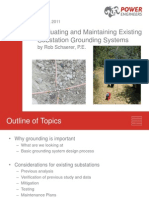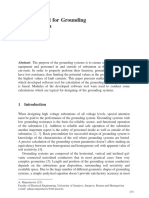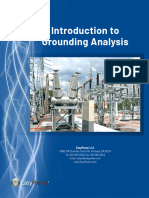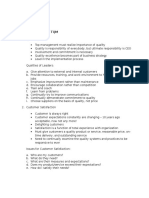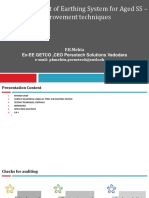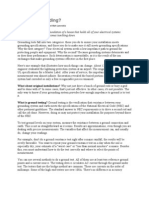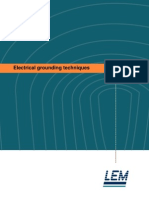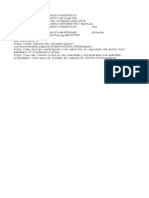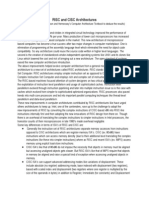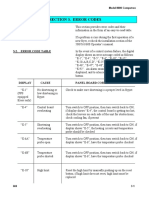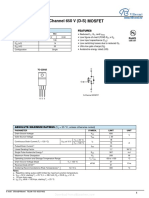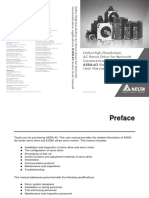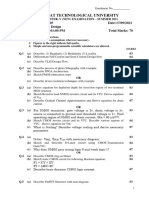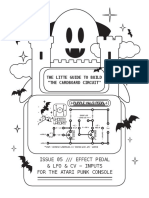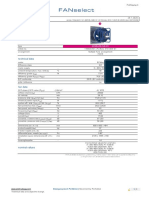®
EasyPower is Part of
Bentley Systems
10 Common
Misconceptions for
Grounding Analysis
1 – Grounding System Performance
Fluctuates
It may not be apparent, but local site modifications
such as new breakers, transformers, and general
layout changes as simple as fence-line modifications
INTRODUCTION could result in touch voltage hazards in previously
An important aspect of a compliant sites. Additionally, offsite utility system
grounding system design is changes may affect the performance of a grounding
personnel and public safety. system. The addition of a new switchyard, transmis-
It is important to reduce the sion lines, or generation may increase the power
misconceptions regarding system fault current availability and corresponding
grounding system design, touch and step voltage hazards.
as personnel are dependent
Additionally, soil resistivity may vary significantly
on these buried systems
based on the seasonal and climatic changes at a site,
and typically unable to di- which significantly affects the grounding system
rectly evaluate their condi- performance. Figure 1 shows most of a system is
tion while on-site. Ground- within permissible limits, in green, but as ambient
ing system performance temperatures decrease, the native soil resistivity
is affected by multiple increases resulting in exceeding permissible touch
variables simultaneously, voltage limits throughout the site, shown in Figure 2.
often resulting in designs
unique to a site. This makes
standard grounding system
designs practically impos-
sible, highlighting the need
for proper guidance in the
design of these complex
systems.
Figure 1. Summer Grounding System Performance
©2023 Bentley Systems | EasyPower, 15862 SW 72nd Ave, Suite 100, Portland, OR 97224, USA | Tel. 503-655-5059 | www.EasyPower.com
� Table 1. Assumed Soil Model Outcomes
Soil Resistivity 50 Ω-m 300 Ω-m
Impedance (Ω) 0.49 2.88
Ground Potential Rise (V) 4,855 28,853
Permissible Touch (V) 280 381
Permissible Step (V) 340 745
3 – Soil Measurement Errors
Soil resistivity test values are simple to per-
form, but there are several ways the testing
can capture errors leading to poor grounding
system designs. Typical soil resistivity mea-
Figure 2. Winter Grounding System Performance surement errors are related, but not limited
to, probe continuity, test device limitations,
Consider these performance fluctuations with
and interference. If undetected, erroneous soil
safety margins in the design and use of Sea-
resistivity test values can result in inadequate
sonal Analysis tools from XGSLab to forecast
grounding system designs, or significant over-
seasonal performance.
designs.
Poor continuity of the test probes may be
2 – Assumed Soil Data detected by the test equipment’s error report-
ing, but often the testers must evaluate the
Tables and references for typical soil resistivity
measurement results. Additionally, testing
values are widely available and provide ranges
devices vary in their power and sensitivity
for the expected conductivity of various soil
and persons performing soil resistivity tests
types based on the visual characteristics of the
must be aware of their devices’ capabilities. A
soil. While it may be very useful to reference
piece of test equipment that works well in one
typical soil resistivity data for affirming mea-
region may have challenges in another. Add-
surements, these values cannot be used for
ing saline solution to the probes or connecting
final grounding system designs.
additional probes in parallel at test locations
As an example, while a material may be visu- may improve continuity between the soil and
ally characterized as sandy clay, typical resistiv- test device measurements.
ity may be as low as 50 Ω-m or as high as 300
Signs of erroneous soil resistivity measure-
Ω-m. The resulting ground potential rise could
ments include soil resistivity values outside
be six times larger assuming a soil resistivity
of normal ranges or rising calculated soil
on the lower end of this range, while higher
resistance values at increasing depths. Table 2
resistivities could result in higher permissible
shows a table of soil resistivity measurements
touch and step voltages.
with an error in the 40 foot “a-spacing” value as
Table 1 shows the effects for the same ground- soil resistance should decrease with increasing
ing system design when assuming a lower depth/probe spacing.
versus higher soil resistivities.
©2023 Bentley Systems | EasyPower, 15862 SW 72nd Ave, Suite 100, Portland, OR 97224, USA | Tel. 503-655-5059 | www.EasyPower.com
� Table 2. Erroneous Soil Resistivity Measurements
Probe A-Spacing (ft). Resistance (Ω)
1.5 11.39
3 5.79
5 3.41
10 1.62
15 1.06
20 0.81
25 0.63
30 0.52
40 0.63 At a minimum, soil resistivity should be mea-
50 0.32 sured to a depth equivalent to the diagonal
70 0.2 distance of the overall grounding system, or
90 0.2 an appreciable percentage of this distance as
feasible. If soil resistivity changes are observed
Note - Values in red indicate errors
with increasing depth, greater depths (longer
Soil resistivity testing should not be performed measurement traverses) are recommended.
over or immediately adjacent to an existing Similarly, engineers performing grounding
grounding system, as the injected test cur- system design for geographically large facili-
rent will enter the metallic grounding system, ties may consider taking multiple separate soil
skewing measurement of the native soil. Physi- resistivity measurements at different locations
cal interference occurs when metallic objects throughout the facility to characterize hori-
such as metallic pipes or fencing within the zontal changes in soil resistivity.
hemispherical range of the measurement
traverses lead to inaccurate results. Performing
perpendicular measurement traverses allows 5 – Ground Current Necessary for
for testing personnel to detect this type of Ground Potential Rise
interference. Fault information is typically simulated from a
utility’s power system model, including fault
4 – Insufficient Soil Test Arrangement current magnitude, clearing time, and X/R
ratio for each voltage level at a facility. A com-
Soil resistivity should be measured to a suffi- mon misconception is that the three-phase
cient depth such that effects related to vertical fault current should be used for evaluating
soil resistivity stratification on grounding sys- grounding system performance. Ground cur-
tem performance are analyzed. Increasing the rent is necessary to produce a ground poten-
soil resistivity measurement traverse lengths tial rise and cause the corresponding touch
yields more information about the stratifica- and step voltage hazards to occur. Three-
tion of soil resistivity at increasing depths. phase faults do not have a zero-sequence
Conversely, shorter traverse lengths yield current component and therefore will not
information about the soil resistivity at shal- produce touch nor step voltage hazards
lower depths. Larger grounding systems have throughout a site.
increased zones of influence and thus require
longer traverses of soil resistivity measure- Ground current (zero-sequence current) is
ments. The IEEE Std 81-2012 indicates that tak- present during single-line-to-ground faults
ing soil resistivity measurements to insufficient and double-line-to-ground faults. For either of
depths may result in grounding system being these fault conditions, engineers should evalu-
under designed by as much as 110%. ate touch and step voltages hazards.
©2023 Bentley Systems | EasyPower, 15862 SW 72nd Ave, Suite 100, Portland, OR 97224, USA | Tel. 503-655-5059 | www.EasyPower.com
�6 – Fault Current Split 7 – Remote Versus Local Fault
Contribution
For many ground fault events, a portion of
the current will take alternative paths that do Grounding system studies refer to a remote
contribute to a ground potential rise (GPR) of source as a system that when sufficiently far
the grounding system under analysis. Deter- from the site under evaluation there is no resis-
mining the fault current split provides the tive coupling.
percentage of fault current that goes through
the grid producing a GPR and the portion that For many substations, the high-voltage fault is
takes alternative paths reducing the maximum sourced from remote stations as illustrated in
GPR. Considering the fault current split allows Figure 3, where ground current travels through
for a more accurate analysis and more efficient the grounding system resulting in a ground
grounding system design. Alternative paths potential rise.
often include a transmission line’s overhead
wires, distribution neutral wires, and cable Note that current returning through the earth
shielding and armor. There are several meth- path at the source-end of the electric sys-
ods for calculating the fault current split, but tem also yields a ground potential rise at the
a common simplified approach is to calculate source, which is discussed in the next section.
or reference the equivalent impedance of the
alternative paths and enter those Req and Xeq
values into the XGSLab split factor tool.
Figure 3. Remote Fault Source
More thorough investigation is performed
by software, such as NETS, that use the phase
component method to model a complicated
meshed power system such as multiple sta-
tions feeding a fault at a substation. The NETS
model shows a 30.7 kA phase A fault, but only
2.56 kA will produce a GPR (through e) with Figure 4. Local Fault Contribution
the remaining taking the transmission shields When a local source contributes to a fault,
and cable neutrals paths (D). that current will return via directly connected
©2023 Bentley Systems | EasyPower, 15862 SW 72nd Ave, Suite 100, Portland, OR 97224, USA | Tel. 503-655-5059 | www.EasyPower.com
�metallic paths back to its source and does not 9 – Software Calculation Methods
contribute to the calculated touch and step
voltage magnitudes, as shown in Figure 4. Computer calculations offer numerous advan-
tages when compared against hand calcula-
Local sources of ground fault current include tion approaches to grounding system design.
generators, autotransformers, or other local Several software solutions exist that provide
delta/wye-grounded transformers where low- simple methods for evaluating grounding
side ground faults may return to the trans- system performance and many users may not
former neutral. realize that many software tools incorporate
assumptions into their calculation approaches.
The local fault contribution may be more than
For some sites, these assumptions made by
50% of the total ground fault current. Analyz-
software solutions can result in false indica-
ing only faults that occur locally on the site will
tions of compliance (or noncompliance) with
underestimate the touch and step voltages as
touch and step voltage limits.
a remote ground fault can produce the largest
ground potential rise and possibly the worst A common assumption for first generation
touch and step voltage hazards. Engineers grounding software use of a “superconductor”
should consider both local and remote ground where they ignore the voltage drop on the
faults when designing grounding systems to ground grid. Often referred to as equipotential
ensure that worst-case conditions for touch plane, using the wrong analysis could lead to
and step voltage hazards are assessed. dangerous under-design, or expensive over-
design. XGSLab calculates self and mutual
impedances, showing the 100V+ difference of
8 – Intermittent Touch Voltage the ground grid.
Hazards
For touch voltage hazards to be present, there
must be a grounded, metallic object that
personnel may touch. In power systems, some
areas with significant voltage gradients may
not require grounding conductor if there are
no objects in the vicinity to touch. This allows
for optimized grounding system designs that
protect individuals from touch voltage haz-
ards only in selected locations. Objects such
as service vehicles, temporary equipment, and
fence gates may be intermittently present in
certain locations. Grounding systems should
provide personnel with adequate protection Contact Sales@easypower.com to request our
from touch voltage hazards for intermittently “Limitations of Simple Grounding Software”
present objects. When reviewing a grounding guide for more details on simple software
system design, the presence of ground loops limits!
extending out to encompass the swing of
gates are a good indication of a proper design
that accounts for intermittent objects.
©2023 Bentley Systems | EasyPower, 15862 SW 72nd Ave, Suite 100, Portland, OR 97224, USA | Tel. 503-655-5059 | www.EasyPower.com
�10 – Sampling Earth Surface Figure 6 provides an example of a sparse
Potentials calculation, with few analysis points from one
grounding conductor to another, missing max-
Analysis tools allow for precise calculation of imum and minimum earth surface voltages.
the earth’s surface potentials to determine
touch and step voltages. The calculation of the
earth’s surface potentials is commonly evalu-
ated by sampling at specified steps or spacings
and most commercially available software
can adjust this criterion as different sampling
amounts may be necessary for different sites
and evaluations.
Figure 5 shows an adequately dense sampling
of potentials with multiple points moving out-
ward from one ground conductor to the next.
Figure 6. Sparse Earth Surface Potential Calculations
Sparse calculations of earth’s surface poten-
tials are more likely to miss the maximum and
minimum surface potentials’ locations, which
typically correspond to the worst-case touch
or step voltage hazards
Figure 5. Dense Earth Surface Potential Calculations
XGSLab is one of the most powerful
software packages for grounding system
analysis, electromagnetic fields, AC
interference, and lightning analysis. Download your FREE copy of our booklet
Download a Free Demo Intro to Grounding Analysis
www.easypower.com/xgslab-demo www.EasyPower.com/groundingbook
©2023 Bentley Systems | EasyPower, 15862 SW 72nd Ave, Suite 100, Portland, OR 97224, USA | Tel. 503-655-5059 | www.EasyPower.com
�XGSLab Software
XGSLab is one of the most powerful software packages for grounding system analysis, electromag-
netic fields, AC interference, and lightning analysis. It is used worldwide for:
• Grounding System Analysis
• Multilayer/Zone Soil Models
• Below and Above Ground Systems
• Cathodic Protection Systems
• Magnetic & Electric Fields
• Electromagnetic Interferences
• Fault Current Distribution
• Lightning Shielding and Analysis
• Time and Frequency Domain
Applications
XGSLab Modules
The following table summarizes the main applications of the
XGSA_TD
XGSA_FD
available models.
SHIELD
GSA_FD
NETS
GSA
Grounding (equipotential systems)
Grounding (general conditions)
Cathodic Protection Systems
Magnetic Field
Electric Field
Electromagnetic Interferences
Corona Effects
Switching Transients, Lightning and Fault Transients in GIS
Steady State Solver for Full Meshed Multi-conductor and Multi-phase Networks
Short Circuit Current on Full Meshed Multi-conductor and Multi-phase Networks
Fault Current Distribution on Full Meshed Multi-conductor and Multi-phase Networks
Lightning Shielding
Contact Sales@EasyPower.com to get answers to any questions or set up a one-on-one free demo of
the capabilities of the XGSLab software. You can also request a quote (www.EasyPower.com/quote).
You can learn more about XGSLab by visiting our website at: www.EasyPower.com/grounding
For more resources to help you with grounding, lightning and EMF needs, visit the EasyPower web-
site and go to the Grounding Resource Center.
www.EasyPower.com/groundingcenter
Follow EasyPower
®
EasyPower is Part of
Bentley Systems
©2023 Bentley Systems | EasyPower, 15862 SW 72nd Ave, Suite 100, Portland, OR 97224, USA | Tel. 503-655-5059 | www.EasyPower.com


